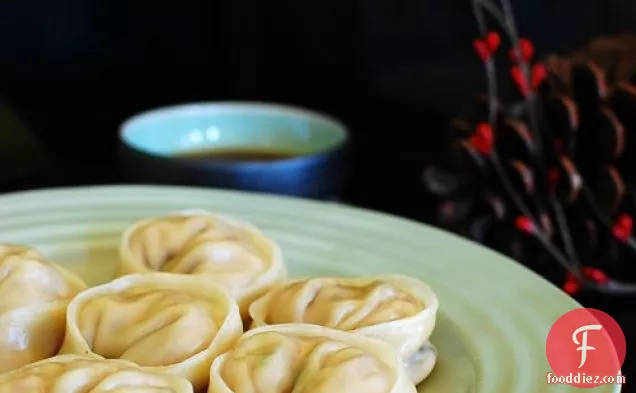Mandu (Korean dumplings)

Mandu (Korean dumplings) might be just the hor d'oeuvre you are searching for. One portion of this dish contains around 3g of protein, 2g of fat, and This recipe is typical of Korean cuisine. Head to the store and pick up kimchi, sesame oil, egg, and a few other things to make it today.
Instructions
1
Finely chop the kimchi and squeeze out as much liquid as possible by hand. Squeeze out water from tofu.I usually place tofu under a heavy object such as cutting board to press out water first and then squeeze by hand. Also, using a cheesecloth will make squeezing easier. Blanch the bean sprouts in boiling water, drain, chop and squeeze out water. Finely chop the onion and squeeze out water. Finely chop the scallions.The squeezed ingredients should be dry and crumbly.
Ingredients you will need![Bean Sprouts]() Bean Sprouts
Bean Sprouts![Green Onions]() Green Onions
Green Onions![Kimchi]() Kimchi
Kimchi![Onion]() Onion
Onion![Water]() Water
Water![Tofu]() Tofu
Tofu
Equipment you will use![Cutting Board]() Cutting Board
Cutting Board![Cheesecloth]() Cheesecloth
Cheesecloth
Ingredients
1pinch![pinch of black pepper]() pinch of black pepper25
pinch of black pepper25![25 – 30 dumpling wrappers (slightly thick)]() 25 – 30 dumpling wrappers (slightly thick)1
25 – 30 dumpling wrappers (slightly thick)1![egg (use the other half to seal the wrappers)]() egg (use the other half to seal the wrappers)1Tbsp
egg (use the other half to seal the wrappers)1Tbsp![minced garlic]() minced garlic1teaspoon
minced garlic1teaspoon![finely grated ginger (or juiced)]() finely grated ginger (or juiced)113grams
finely grated ginger (or juiced)113grams![ground pork (and/or beef)]() ground pork (and/or beef)237milliliters
ground pork (and/or beef)237milliliters![(packed) finely chopped kimchi]() (packed) finely chopped kimchi227grams
(packed) finely chopped kimchi227grams![mung bean sprouts]() mung bean sprouts1mediums
mung bean sprouts1mediums![onion]() onion1pinch
onion1pinch![pinch pepper]() pinch pepper1pinch
pinch pepper1pinch![pinch of red pepper flakes (gochugaru)]() pinch of red pepper flakes (gochugaru)0teaspoons
pinch of red pepper flakes (gochugaru)0teaspoons![salt to taste (about]() salt to taste (about3
salt to taste (about3![scallions]() scallions2teaspoons
scallions2teaspoons![sesame oil]() sesame oil1Tbsp
sesame oil1Tbsp![soy sauce]() soy sauce2teaspoons
soy sauce2teaspoons![soy sauce]() soy sauce1teaspoons
soy sauce1teaspoons![sugar]() sugar170grams
sugar170grams![tofu]() tofu1teaspoon
tofu1teaspoon![vinegar]() vinegar1Tbsp
vinegar1Tbsp![water]() water
water
 pinch of black pepper25
pinch of black pepper25 25 – 30 dumpling wrappers (slightly thick)1
25 – 30 dumpling wrappers (slightly thick)1 egg (use the other half to seal the wrappers)1Tbsp
egg (use the other half to seal the wrappers)1Tbsp minced garlic1teaspoon
minced garlic1teaspoon finely grated ginger (or juiced)113grams
finely grated ginger (or juiced)113grams ground pork (and/or beef)237milliliters
ground pork (and/or beef)237milliliters (packed) finely chopped kimchi227grams
(packed) finely chopped kimchi227grams mung bean sprouts1mediums
mung bean sprouts1mediums onion1pinch
onion1pinch pinch pepper1pinch
pinch pepper1pinch pinch of red pepper flakes (gochugaru)0teaspoons
pinch of red pepper flakes (gochugaru)0teaspoons salt to taste (about3
salt to taste (about3 scallions2teaspoons
scallions2teaspoons sesame oil1Tbsp
sesame oil1Tbsp soy sauce2teaspoons
soy sauce2teaspoons soy sauce1teaspoons
soy sauce1teaspoons sugar170grams
sugar170grams tofu1teaspoon
tofu1teaspoon.webp) vinegar1Tbsp
vinegar1Tbsp water
waterRecommended wine: Chenin Blanc, Gewurztraminer, Riesling
Korean on the menu? Try pairing with Chenin Blanc, Gewurztraminer, and Riesling. The best wine for Asian food depends on the cuisine and dish - of course - but these acidic whites pair with a number of traditional meals, spicy or not. The Lubanzi Chenin Blanc with a 4.1 out of 5 star rating seems like a good match. It costs about 16 dollars per bottle.

Lubanzi Chenin Blanc
The 2018 Lubanzi Chenin Blanc is drawn from a blend of older, dry farmed bush vines & younger, drip irrigated vines. Its deep straw color points towards both ripe freshness & complexity. The nose brings tropical & stone fruits first, eliciting thoughts of tangerine & lychee. The palate is round and fleshy, pushing forward lychee again, along with white peach, apricot & green apple, all carried by a touch of elevated acidity. There is brightness & a slight hint of freshly baked bread throughout. The finish is long, soft & affectionate.DifficultyHard
Ready In45 m.
Servings25
Health Score2
Related recipes
Easy Pad Thai
Thai Peanut Lime Sauce
Indian Bread Pudding (Double Ka Meeta)
Vietnamese Pork Lettuce Wraps
Magazine

Your Inner Chef with Taylor Swift's Top 3 Recipes from Her Beloved NYC Hangout

20 Mouthwatering Recipes You Need to Try Today!

Master the Art of Making Perfect Pancakes with This Foolproof Recipe

The Science Behind Red Wine: Its Surprising Health Benefits and Potential Risks

12 Wine Cocktails for a Sophisticated Twist

Sip, Swirl, and Celebrate: Toasting to National Wine Day on May 25th

National Drink Wine Day on February 18

Celebrating Souffle Day with Delectable Delights

Indulge in the Delightful Flavor of Oyster Soup on Its Special Day!

Celebrating World Nutella Day

17 No-Fuss Ideas For When You Dont Know What to Make For Dinner

15 Simple Dinner Ideas for Healthy Eating in Real Life

15 Winter Vegetables That Are Seriously Good for You

Traditional South American Foods

Traditional Scandinavian foods

Traditional Middle Eastern Foods

Traditional Mediterranean foods

Seasonal January Foods and What to Cook with Them

Fruits to Eat in January

How to Preserve Lemons

Your Inner Chef with Taylor Swift's Top 3 Recipes from Her Beloved NYC Hangout

Celebrate National Pizza Day on February 9th with Mouthwatering Slices and Fun Facts

Vegetarian soup recipes are not just for vegetarians anymore

A Collection of 15 Noodle Soup Recipes to Warm Your Soul

Vibrant World of South Asian Food Trucks at the Mississauga Festival

10 Foods that Relieve Constipation Naturally

7 Indian Foods That Have Been Declared the Best in the World

Indiana's Exciting Addition to the Summer Food Program for School Children

Exploring 20 Global Comfort Dishes to Soothe Your Sickness



